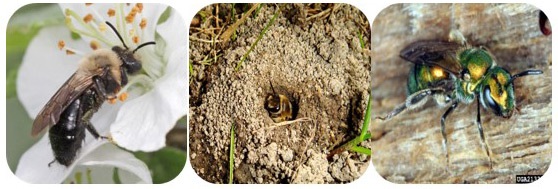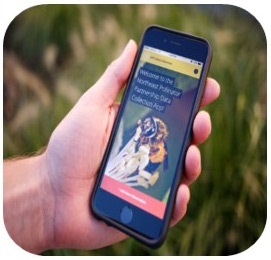Wild bees in apple orchards
Learn about the contribution of wild bees to pollination in apple orchards.
Apples require cross-pollination between different cultivar or crabapple pollinizers to set fruit. Insect pollinators are recruited to accomplish this task, lured to blossoms by visual cues, fragrances, nectar, and pollen by the mass-flowering crop. Even though only a relatively small percentage of blossoms need to be pollinated for a commercial crop, full seed set is required to produce large, high quality fruit. In Ontario, honey bees are traditionally used to complete this critical task, at a recommended rate of 2 to 3 (healthy) colonies per hectare to provide satisfactory pollination.
Honey bees and bumble bees are commonly known pollinators of many agricultural crops, but did you know there are over 400 species of wild bees that call Ontario home (Figure 1)? The vast majority of bees are solitary, meaning there is a single female that establishes and maintains her nest. Most solitary bees nest in the ground. These nests consist of a tunnel and a series of individual chambers, or cells, all of which are excavated by the female. Each cell is provisioned with a mixture of pollen and nectar ("pollen ball") upon which the female lays an egg. Cells are sealed up, and the egg develops into a larva, a pupa, and eventually, a new adult that has to dig its way out of the nest, before the cycle starts again.
In other production regions, researchers have found wild bees can contribute significantly to pollination of apples. Here are some of the basic findings:
- Bee diversity is a good predictor of pollination services, seed set, and fruit set in apples. Wild bee diversity and abundance each drive up apple production, while honey bee abundance does not. Increasing numbers of honey bees will not compensate for losses of wild bees. In areas where wild bee populations are robust, adding honey bees does nothing to increase marketable yield.
- Natural habitat increases species diversity. Increasing natural habitat in the landscape around orchards leads to higher abundance and diversity of wild bees, and buffers against potential impacts of pesticide use.
- Increasing pesticide use lowers abundance and diversity of wild bees. There is recent evidence that some fungicides have a negative impact on bees. Wild bee populations tend to be higher in IPM versus conventional orchards. Bees still visit flowers after petal fall, because the remaining nectar is attractive.
- Not all cultivars are equally attractive. Cultivar blooms vary in terms of form, internal morphology, and the distribution of pollen on the stigmas required for a full complement of seeds. Pollinator foraging behavior, floral attractiveness, pollination requirements, pollen tube growth pathways, and other characteristics are not considered during new cultivar development.
- Wild bees are more successful at pollen transfer. Wild bees tend to carry more pollen on their bodies, deposit more pollen grains on the flower stigma, and have greater "pollen purity" (preferences for pollen sources). Wild bees, including bumble bees, almost always "top work" the blossom, a flower handling behavior that promotes pollen transfer, whereas honey bees often "side work" flowers, and often rob nectar without transferring any pollen.
- Wild solitary bees are primarily after pollen. This is used to feed their developing young. Nectar is used to fuel the foraging adult, with a small amount used to help hold pollen balls together in the individual nest cells. A large percentage of honey bees visiting apples are foraging for nectar, not pollen. Nectar is an important fuel for honey bee colonies.
- Wild bees in an orchard influence honey bee behavior. Increased movement between rows and contact with pollenizers may result in increased pollen tube growth and ultimately, increased fruit set.
- Wild bees are more tolerant of adverse weather than honey bees. Many species are active earlier in the spring, at lower temperatures, on windy and rainy days, and are more stable over a wide temperature range. Having a diverse set of pollinators visiting blossoms can help ensure pollination through the bloom period regardless of environmental conditions.
- Density and distribution of floral resources affect foraging patterns. Bees are "central place foragers", coming back to their nests with resources to provision developing young and, in social bees, the rest of their colony. Body size (and colony size) influences maximum foraging distance. Honey bees and bumble bees can travel long distances in search of food (many kilometres). Most solitary bees fly less than 500 metres from their nest, some less than 125 m. This is an important consideration from the standpoint of abundance and diversity in orchards.
- Large orchard blocks tend to have less wild bee diversity and abundance (border effect). With some bee species having limited foraging ranges, increasing suitable habitat within and around a larger block has been found to help fill in pollination gaps due to distance.
- Activity can be season-long. Some specialist species are only active for a short window of time around apple bloom, but many others are foraging for months, sometimes from March into October (or even later). These bees need access to forage plants over the entire season in order for populations to thrive.
- Early flowering tree species and forbs (pussy willow, serviceberry, red maple, willow, and redbud) are important pollen sources for wild pollinators. The presence of these species in the landscape might help explain why natural / semi-natural habitat is correlated to wild bee abundance and diversity.
Three basic needs of wild bees include:
- Adequate food during their activity periods.
- Safe (undisturbed) nesting sites with access to clean water.
- Protection from pesticides.
Want to find out if wild bees are abundant on your farm?
A joint project in spring 2018 by the University of Guelph and OMAFRA apple team will be looking at the diversity and abundance of pollinator communities in Ontario apples. This will involve collection and identification of blossom visitors during the bloom period of high-value cultivars in a number of orchards throughout the province. If you are interested in participating in this survey, contact a member of the OMAFRA apple team:
- Hannah Fraser - hannah.fraser@ontario.ca or
519-824-4120 ext 52671 - Kristy Grigg-McGuffin - kristy.grigg-mcguffin@ontario.ca or
519-426-4322 - Amanda Green - amanda.green@ontario.ca or
519-426-1102
Yes, there's an app for that!
Participate in the Northeastern Apple Pollinator Data Collection project by downloading the Pollinator App to collect bee count data. The interactive guide helps you easily identify and distinguish native bees from honey bees while the actual assessment takes only three 5-minute observations per orchard to determine your wild bee diversity. All information is kept confidential. For more information, visit Northeast Pollinator Partnership.
References
- Mallinger RE, Gratton C (2015) Species richness of wild bees, but not the use of managed honey bees, increases fruit set of a pollinator-dependent crop. Journal of Applied Ecology. 52, 323-330.
- Martins KT, Gonzales A, Lechowicz MJ (2015) Pollination Services are Mediated by bee Functional Diversity and Landscape Context. Agriculture, Ecosystems and Environment. 200 (215) 12-20.
- Park M et al. (2015) Wild Pollinators of Eastern Apple Orchards and How to Conserve Them 2nd ed. Cornell University, Penn State University, and the Xerces Society.
- Park MG, Blitzer EJ, Gibbs J, Losey JE, Danforth BN (2015) Negative effects of pesticides can be buffered by landscape context. Proc. R. Soc. B 282:20150299.
- Rands SA, Whitney HM (2011) Field margins, foraging distances and their impacts on nesting pollinator success. PLoS One 6(10)e25971.
- Russo L, Park M, Gibbs J, Danforth B (2015). The challenge of accurately documenting bee species richness in agroecosystems: bee diversity in eastern apple orchards. Ecology and Evolution 5917):3531-3540.
- Russo L, Park MG, Blitzer EJ, Danforth BN (2017). Flower handling behavior and abundance determine the relative contribution of pollinators to seed set in apple orchards. Agriculture, Ecosystems and Environment 246:102-108.

